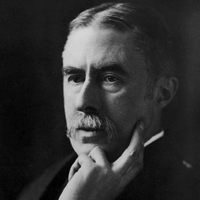Loveliest of Trees by Alfred Edward Housman: Critical Analysis
The poem Loveliest of Trees is a romantic poem. The speaker is probably on horse-track in the woods and is facing a lovely cherry tree in full blossom. He is so fascinated by its beauty that he thinks fifty years long time would be insufficient to enjoy and satisfy himself. He says that he has spent twenty years already and he thinks he will live fifty more.

Alfred Edward Housman
He is nostalgic about the past and thirsty of youthful pleasures. The poem is deceptively simple. The cherry tree is a symbol of youth and beauty. But a few hints in the poem betray the simple surface meaning. First, the flowers are either covered with cold snow or “the cherry tree (is) hung with snow” only, rather than real flowers! Second, the cherry tree is “wearing white for Eastertide,” the festival that reminds the death of a youthful Jesus, and his resurrection. These clues may be interpreted against the apparent “romanticism” and pleasures of youth in the poem. Finally, we are made to feel that the poet seems to suggest that we must enjoy the nature as much as we can, despite the potential tragedies in life.
One of the main themes of the poem is the brevity (shortness) of life. Youth is even shorter like spring. The best the speaker can do is to be presently excited and to enjoy the present at his best. His determination to enjoy with the nature till his death will in reality be impossible: youth will pass and so will the excitements. Similarly, it is ironical that the beautiful blossoming tree is covered by snow. The cold and difficulties of life also cover youth and its pleasures. The best we can do is to enjoy the challenges. The apparent beauty is also full of such other meanings.
The nature is indifferent to man. The trees will blossom more or less similarly even after the man’s youth or life is over. Man’s projection of feelings into the nature is illusory. The nature is indifferent and ignorant about its own beauty. The process of nature doesn’t spare anyone from change and death.
On the simple surface level of its meaning the poem deals with the issue of the beauty of nature and the poet’s wish to enjoy it as much as he can. Of course, these are the simple themes of the poem. But on a closer analysis, we understand that the poet is also revealing some ironies about nature and human life. In the first two lines we feel that the cherry tree is in full bloom and it is an exciting spring. But if we read the third and fourth lines carefully, we see that the tree is “wearing white” as if in mourning. Moreover, the Easter is also the Christian festival related to the death of the young Christ. That at least reminds that there is no guarantee of our lifespan. And when the poet confidently says that he will live fifty more years, it becomes an irony. Thus, the theme of the poem also includes the irony of the shortness and uncertainty of life. The nature is not sympathetic to human problems; it is not even conscious of its own beauty. It will go on blossoming like that as a process of its continuity, whether or not the poet remains to appreciate it. Even beauty is man’s interpretation, and the nature is neither happy nor sad. Happy men find the nature happy and the sad find it sad. But the nature is indifferent to men.
Similarly, the poem also contains the theme of nostalgia, or the wish or regret about the past. The poet says the twenty springs of his life will not come again. Besides, the poet also expresses the anxiety about the shortness of his life to come. And because of the consciousness of that shortness or life, he decides to “enjoy the day”. That is called the “Carpe diem” theme of classical poetry.
The poem is also highly musical. It is mainly in iambic tetrameter; each line has four beats, the stressed syllables follow stressed syllables alternately. However, the poet makes the poem rhythmically playful by frequently using rhythmic variations. Besides, the simplicity of diction, short lines, short stanzas, and the expression in the first person (I) also adds to the lyrical quality of the poem. The rhythms in the poem support the romantic sense as well as its more complex variations in meaning. Normally it sounds like children’s poetry in tetrameter. Five lines begin in trochaic foot and have catalectic ending. Seven lines are in iambic meter. The narrative is unusually in the present tense, and it flows easily. We can also call it dramatic in a situation and expression. The rhyme also helps the poem flow easily and regularly in pairs. In theme, it is mixed up. At best, the 'Carpe diem' idea could be called the most reliable moral, if any.
Literary Spotlight
Introduction of Loveliest of Trees
Biography of Alfred Edward Housman
 |
bachelorandmaster.com |